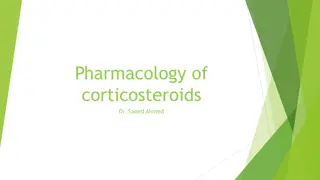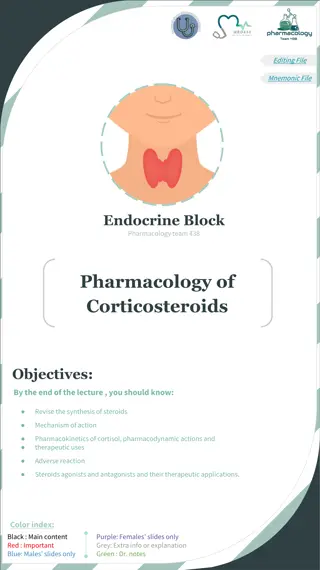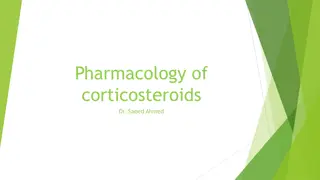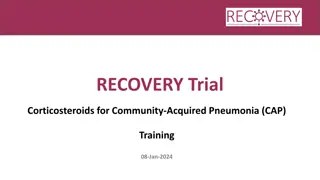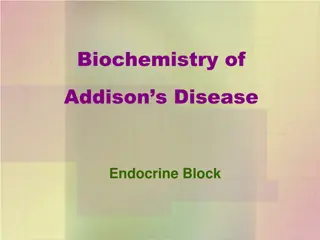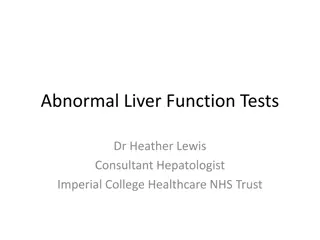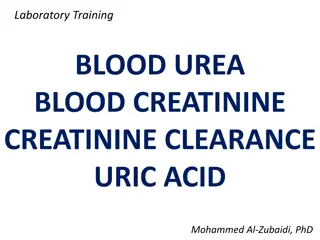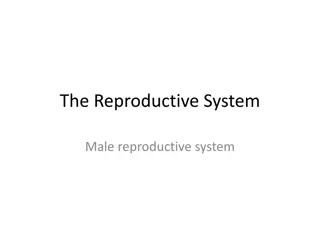Understanding the Role of Corticosteroids in Adrenal Function
The adrenal gland consists of the cortex and the medulla, each responsible for secreting different hormones. The cortex produces glucocorticoids, mineralocorticoids, and adrenal androgens, while the medulla secretes catecholamines. Corticosteroids play a crucial role in regulating metabolism, stress response, and immune function. They bind to specific receptors in target tissues and act as transcription factors to regulate gene expression. Glucocorticoids, such as cortisol, play a key role in promoting intermediary metabolism, increasing stress resistance, and influencing blood cell levels. Understanding the mechanisms of corticosteroid action is essential for diagnosing and treating adrenal disorders.
Download Presentation

Please find below an Image/Link to download the presentation.
The content on the website is provided AS IS for your information and personal use only. It may not be sold, licensed, or shared on other websites without obtaining consent from the author. Download presentation by click this link. If you encounter any issues during the download, it is possible that the publisher has removed the file from their server.
E N D
Presentation Transcript
The adrenal gland consists of the cortex and the medulla. The medulla secretes catecholamines, whereas the cortex secretes two types of corticosteroids (glucocorticoids and mineralocorticoids) and the adrenal androgens. The adrenal cortex has three zones, and each zone synthesizes a different type of steroid hormone from cholesterol. The outer zona glomerulosa produces mineralocorticoids (for example, aldosterone) that are responsible for regulating salt and water metabolism. Production of aldosterone is regulated primarily by the renin angiotensin system. The middle zona fasciculata synthesizes glucocorticoids (for example, cortisol) that are involved with metabolism and response to stress. The inner zona reticularis secretes adrenal androgens Secretion by the two inner zones and, to a lesser extent, the outer zone is controlled by pituitary adrenocorticotropic hormone (ACTH; also called corticotropin), which is released in response to hypothalamic corticotropin- releasing hormone (CRH). Glucocorticoids serve as feedback inhibitors of ACTH and CRH secretion. Both natural and synthetic corticosteroids are used for the diagnosis and treatment of disorders of adrenal function. They are also used more often and in much larger doses for treatment of a variety of inflammatory and immunologic disorders.
corticosteroids The corticosteroids bind to specific intracellular cytoplasmic receptors in target tissues. Glucocorticoid receptors are widely distributed throughout the body, whereas mineralocorticoid receptors are confined mainly to excretory organs, such as the kidney, colon, salivary glands and sweat glands. Both types of receptors are found in the brain. After dimerizing, forming of a dimer , the receptor hormone complex recruits coactivator (or corepressor) proteins and translocates into the nucleus, where it attaches to gene promoter elements. There it acts as a transcription factor to turn genes on (when complexed with coactivators) or off (when complexed with corepressors), depending on the tissue through binding to a glucocorticoid response element (GRE) on the regulatory region of the gene, and regulate transcription by RNA polymerase II and associated transcription factors. The resulting mRNA is edited and exported to the cytoplasm for the production of protein that brings about the final hormone response. This mechanism requires time to produce an effect. However, other glucocorticoid effects are immediate, such as the interaction with catecholamines to mediate relaxation of bronchial musculature.
A. Glucocorticoids Cortisol is the principal human glucocorticoid. Normally, its production is diurnal, with a peak early in the morning followed by a decline and then a secondary, smaller peak in the late afternoon. Factors such as stress and levels of the circulating steroid influence secretion. The effects of cortisol are many and diverse. In general, all glucocorticoids: 1. Promote normal intermediary metabolism: Glucocorticoids favor gluconeogenesis through increasing amino acid uptake by the liver and kidney and elevating activities of gluconeogenic enzymes. They stimulate protein catabolism (except in the liver) and lipolysis, thereby providing the building blocks and energy that are needed for glucose synthesis. 2. Increase resistance to stress: By raising plasma glucose levels, glucocorticoids provide the body with energy to combat stress caused by trauma, fright, infection, bleeding, or debilitating disease. 3. Alter blood cell levels in plasma: Glucocorticoids cause a decrease in eosinophils, basophils, monocytes, and lymphocytes by redistributing them from the circulation to lymphoid tissue. Glucocorticoids also increase hemoglobin, erythrocytes, and platelets.
4.Have anti-inflammatory action: The most important therapeutic properties of the glucocorticoids are their potent anti-inflammatory and immunosuppressive activities. These therapeutic effects of glucocorticoids are the result of a number of actions: The lowering of circulating lymphocytes is known to play a role. Glucocorticoids inhibit the ability of leukocytes and macrophages to respond to mitogens and antigens. Glucocorticoids also decrease the production and release of proinflammatory cytokines. They inhibit phospholipaseA2, which blocks the release of arachidonic acid (the precursor of the prostaglandins and leukotrienes) from membrane-bound phospholipid. The decreased production of prostaglandins and leukotrienes is believed to be central to the anti-inflammatory action. Lastly, these agents influence the inflammatory response by stabilizing mast cell and basophil membranes, resulting in decreased histamine release. 5. Affect other systems: High levels of glucocorticoids serve as feedback inhibitors of ACTH production and affect the endocrine system by suppressing further synthesis of glucocorticoids and thyroid-stimulating hormone. In addition, adequate cortisol levels are essential for normal glomerular filtration. The effects of corticosteroids on other systems are mostly associated with adverse effects of the hormones
B. Mineralocorticoids Mineralocorticoids help to control fluid status and concentration of electrolytes, especially sodium and potassium. Aldosterone acts on distal tubules and collecting ducts in the kidney, causing reabsorption of sodium, bicarbonate, and water. Conversely, aldosterone decreases reabsorption of potassium, which, with H+, is then lost in the urine. Enhancement of sodium reabsorption by aldosterone also occurs in gastrointestinal mucosa and in sweat and salivary glands. [Note: Elevated aldosterone levels may cause alkalosis and hypokalemia, retention of sodium and water, and increased blood volume and blood pressure. Hyperaldosteronism is treated with spironolactone.] Target cells for aldosterone contain mineralocorticoid receptors that interact with the hormone in a manner similar to that of glucocorticoid receptors.
Therapeutic uses of the corticosteroids Several semisynthetic derivatives of corticosteroids are available. These agents vary in anti-inflammatory potency, mineralocorticoid activity, and duration of action. Corticosteroids are used in: 1. Replacement therapy for primary adrenocortical insufficiency (Addison disease): Addison disease is caused by adrenal cortex dysfunction (as diagnosed by the lack of response to ACTH administration). It is characterized by muscular weakness, low blood pressure, depression, anorexia, loss of weight and hypoglycaemia. Addison s disease may have an autoimmune etiology, or it may result from destruction of the gland by chronic inflammatory conditions such as tuberculosis. Hydrocortisone, which is identical to natural cortisol, is given to correct the deficiency. Failure to do so results in death. The dosage of hydrocortisone is divided so that two-thirds of the daily dose is given in the morning and one-third is given in the afternoon. [Note: The goal of this regimen is to mimic the normal diurnal variation in cortisol levels.] Administration of fludrocortisone, a potent synthetic mineralocorticoid with some glucocorticoid activity, may also be necessary to supplement mineralocorticoid deficiency. 2. Replacement therapy for secondary or tertiary adrenocortical insufficiency: These disorders are caused by a defect in CRH production by the hypothalamus or in ACTH production by the pituitary. [Note: Under these conditions, the synthesis of mineralocorticoids in the adrenal cortex is less impaired than that of glucocorticoids.] Hydrocortisone is used for treatment of these deficiencies.
3.Diagnosis of Cushing syndrome: Cushing syndrome is caused by hypersecretion of glucocorticoids (hypercortisolism) that results from excessive release of ACTH by the anterior pituitary or an adrenal tumor. [Note: Chronic treatment with high doses of glucocorticoids is a frequent cause of iatrogenic Cushing syndrome.] Cortisol levels (urine, plasma, and saliva) and the dexamethasone suppression test are used to diagnose Cushing syndrome. The synthetic glucocorticoid dexamethasone suppresses cortisol release in normal individuals, but not those with Cushing syndrome. 4. Replacement therapy for congenital adrenal hyperplasia (CAH): CAH is a group of diseases resulting from an enzyme defect in the synthesis of one or more of the adrenal steroid hormones. CAH may lead to virilization in females due to overproduction of adrenal androgens. Treatment of the condition requires administration of sufficient corticosteroids to normalize hormone levels by suppressing release of CRH and ACTH. This decreases production of adrenal androgens. The choice of replacement hormone depends on the specific enzyme defect. 5. Relief of inflammatory symptoms and immunosuppressive therapy Corticosteroids significantly reduce the manifestations of inflammation associated with rheumatoid arthritis , other connective tissue diseases and inflammatory skin conditions, including redness, swelling, heat, and tenderness that may be present at the site of inflammation. These agents are also important for maintenance of symptom control in persistent asthma, as well as management of asthma exacerbations and active inflammatory bowel disease. In noninflammatory disorders such as osteoarthritis, intra-articularcorticosteroids may be used for treatment of a disease flare. Corticosteroids are not curative in these disorders. Corticosteroids are used to prevent graft-versus-host disease following organ or bone marrow transplantation.
6.Treatment of allergies: Corticosteroids are beneficial in the treatment of allergic rhinitis, as well as drug, serum, and transfusion allergic reactions. [Note: In the treatment of allergic rhinitis and asthma, fluticasone and others are applied topically to the respiratory tract through inhalation form a metered dose dispenser. This minimizes systemic effects and allows the patient to reduce or eliminate the use of oral corticosteroids.] 7. In neoplastic disease: in combination with cytotoxic drugs in treatment of specific malignancies (e.g. Hodgkin s disease, acute lymphocytic leukemia) to reduce cerebral edema in patients with metastatic or primary brain tumours (dexamethasone). 8. Acceleration of lung maturation: Respiratory distress syndrome is a problem in premature infants. Fetal cortisol is a regulator of lung maturation. Consequently, a regimen of betamethasone or dexamethasone administered intramuscularly to the mother within the 48 hours proceeding premature delivery can accelerate lung maturation in the fetus.
Pharmacokinetics 1. Absorption and fate: Orally administered corticosteroid preparations are readily absorbed. Selected compounds can also be administered intravenously, intramuscularly, intra-articularly (for example, into arthritic joints), topically, or via inhalation or intranasal delivery. All topical and inhaled glucocorticoids are absorbed to some extent and, therefore, have the potential to cause hypothalamic pituitary adrenal (HPA) axis suppression. Greater than 90% of absorbed glucocorticoids are bound to plasma proteins, mostly corticosteroid-binding globulin or albumin. Corticosteroids are metabolized by the liver microsomal oxidizing enzymes. The metabolites are conjugated to glucuronic acid or sulfate, and the products are excreted by the kidney. [Note: The half-life of corticosteroids may increase substantially in hepatic dysfunction.] Prednisone is preferred in pregnancy because it minimizes steroid effects on the fetus. It is a prodrug that is not converted to the active compound, prednisolone in the fetal liver. Any prednisolone formed in the mother is biotransformed to prednisone by placental enzymes. 2. Dosage: Many factors should be considered in determining the dosage of corticosteroids, including glucocorticoid versus mineralocorticoid activity, duration of action, type of preparation, and time of day when the drug is administered. When large doses of the hormone are required for more than 2 weeks, suppression of the HPA axis occurs. Alternate-day administration of the corticosteroid may prevent this adverse effect by allowing the HPA axis to recover/function on days the hormone is not taken.
Adverse effects Low-dose glucocorticoid replacement therapy is usually without problems but serious unwanted effects occur with large doses or prolonged administration of glucocorticoids. The major effects are as follows: Suppression of the response to infection or injury: opportunistic infection can be potentially very serious unless quickly treated with antimicrobial agents along with an increase in the dose of steroid. Oral thrush (candidiasis, a fungal infection) frequently occurs when glucocorticoids are taken by inhalation, because of suppression of local anti-infective mechanisms. Wound healing is impaired, and peptic ulceration may also occur. Cushing s syndrome. Osteoporosis, with the attendant hazard of fractures, is one of the main limitations to long-term glucocorticoid therapy. These drugs influence bone density both by regulation of calcium and phosphate metabolism and through effects on collagen turnover. They glucocorticoids suppress intestinal Ca2+ absorption, reduce osteoblast function (which deposits bone matrix) and increase the activity of osteoclasts (which digest bone matrix). An effect on the blood supply to bone can result in avascular necrosis of the head of the femur. Hyperglycaemia produced by exogenous glucocorticoids may develop into actual diabetes. Muscle wasting and proximal muscle weakness. In children, inhibition of growth if treatment is continued for more than 6 months.
Central nervous system effects: euphoria, depression and psychosis. Other effects: glaucoma (in genetically predisposed persons), raised intracranial pressure and an increased incidence of cataracts. Topical therapy can also cause skin atrophy, ecchymosis, and purple striae. Sudden withdrawal of the drugs after prolonged therapy may result in acute adrenal insufficiency because of suppression of the patient s capacity to synthesize corticosteroids. Careful procedures for phased withdrawal should be followed. Recovery of full adrenal function usually takes about 8 weeks, although it can take 18 months or more after prolonged high-dose treatment.
Inhibitors of adrenocorticoid biosynthesis or function Several substances have proven to be useful as inhibitors of the synthesis or function of adrenal steroids: ketoconazole, spironolactone, and eplerenone. 1.Ketoconazole: Ketoconazole is an antifungal agent that strongly inhibits all gonadal and adrenal steroid hormone synthesis. It is used in the treatment of patients with Cushing syndrome. 2. Spironolactone: This antihypertensive drug competes for the mineralocorticoid receptor and, thus, inhibits sodium reabsorption in the kidney. It can also antagonize aldosterone and testosterone synthesis. It is effective for hyperaldosteronism and is used along with other standard therapies for the treatment of heart failure with reduced ejection fraction. Spironolactone is also useful in the treatment of hirsutism in women, probably due to interference at the androgen receptor of the hair follicle. Adverse effects include hyperkalemia, gynecomastia, menstrual irregularities, and skin rashes. 3. Eplerenone: Eplerenone specifically binds to the mineralocorticoid receptor, where it acts as an aldosterone antagonist. This specificity avoids the side effect of gynecomastia that is associated with the use of spironolactone. It is approved for the treatment of hypertension and also for heart failure with reduced ejection fraction.


